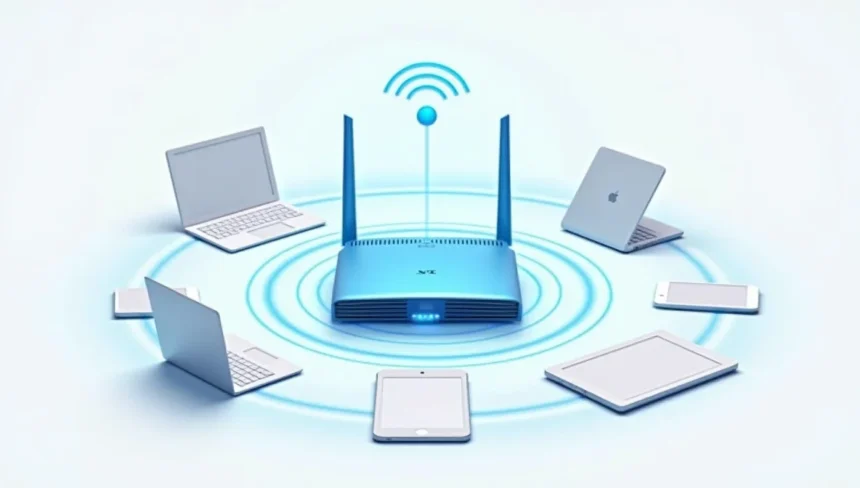In the contemporary world, the Internet should be free and available. In a home, office, or even public place, wireless internet is what we use to communicate, view things online, and conduct business. WiFi and WLAN are terms used interchangeably wherever we happen to be, and that’s why they are misnomers. Both are wireless networking but are not used interchangeably.
This blog will cover the primary differences between WiFi and WLAN, how they work, and how they facilitate wireless Wifi network access today.
What is WLAN?
A WLAN or Wireless Local Area Network is a geographically spread network that enables devices to speak and exchange data with one another wirelessly over a geography. Instead of physical cabling (e.g., Ethernet), WLAN transmits data wirelessly through the assistance of radio waves or infrared light.
How WLAN Works
A WLAN network consists of:
- Access Points (APs) – Radio signal transmission units.
- Wireless routers – Network traffic managing devices inside the network.
Client devices include laptops, mobile phones, tablets, and wireless Internet-of-Things (IoT) devices.
Device-to-device data is exchanged in radio frequencies (RF) to offer network access without wire infrastructure.
WLANs are utilized widely in offices, homes, colleges, and public hotspots to offer a wireless network connection between a sequence of devices.
Types of WLANs
- Infrastructure WLAN – Connects devices to wireless access points and a network hub.
- Ad hoc WLAN – Connects devices without the help of a router to create a wireless peer-to-peer network.
What is WiFi?
WiFi network connection is a wireless technology that offers internet connectivity to devices via a WLAN. It is actually just part of WLAN, which is wireless internet based on the IEEE 802.11 standard.
How Does WiFi Work?
- A router is linked to an internet service provider (ISP) through a wired medium (e.g., DSL, fibre optic).
- The router transmits the wired internet to devices wirelessly.
- Nearby devices scan and join the WiFi network, which gives them the internet.
WiFi Standards
WiFi has evolved with the standards of:
| WiFi Standard | Frequency | Maximum Speed |
| 802.11b | 2.4 GHz | 11 Mbps |
| 802.11g | 2.4 GHz | 54 Mbps |
| 802.11n (WiFi 4) | 2.4 GHz / 5 GHz | 600 Mbps |
| 802.11ac (WiFi 5) | 5 GHz | 1.3 Gbps |
| 802.11ax (WiFi 6) | 2.4 GHz / 5 GHz | 9.6 Gbps |
Every new standard enhances speed, security, and efficiency, providing more reliable Wi-Fi networks for fast internet connections.
WLAN vs. WiFi: Major Differences
While WiFi and WLAN are quite similar, there are a few differences between them.
| Feature | WLAN | WiFi |
| Definition | Wireless Local Area Network | Wireless technology within a WLAN |
| Scope | Encompasses all wireless network types | Refers specifically to IEEE 802.11 wireless networking |
| Function | Enables wireless networking for devices | Provides internet connectivity over a wireless network |
| Connectivity | Can operate without an internet connection | Requires an internet source (router/modem) |
| Technology | Uses RF signals or infrared waves | Uses IEEE 802.11 WiFi standards |
| Example | Enterprise networks, campus WiFi zones | Home and public WiFi hotspots |
Simple Explanation: WiFi is a part of WLAN, although not all WLAN is WiFi.A WLAN offers the potential for devices to become locally wirelessly linked to each other, but WiFi offers an internet connection via a WLAN.WLANs do not need a router to become connected to the internet or to carry an internet connection in order to offer local messages because WiFi networks are not available locally.
Usage of WLAN and WiFi
- Corporate Usage Examples – office appliances utilize WLAN infrastructure to connect.
- Schools & University Usage – students and staff utilize WLAN to access common sources.
- Smart Homes – Smart TV, IoT features, and home automation are interconnected by WLAN.
- Public Transport – trains, buses, and airports utilize WLAN-based networks for intra-netting.
WiFi Applications
- Home Networks – Home groups utilize WiFi routers for wireless internet access.
- Cafes & Public Hotspots- Companies provide free WiFi networks for the benefit of visitors.
- Hotels & Hospitality – visitors in lounges and rooms based on WiFi network access.
- Events & Conferences- Organizers provide WiFi hotspots to visitors and speakers.
Which One Do You Need: WLAN or WiFi?
Your need is the distinction between WiFi and WLAN:
- If you require internet access for more than a single device, WiFi is the requirement.
- If you require an intranet wireless network, WLAN is the solution.
WLAN with support for WiFi in corporate offices and large deployments provides seamless communication and internet access.
Benefits of WLAN
- Unshackled from wired infrastructure, no cables and mess.
- Multiple devices are accessible, with optimum connectivity provided.
- Provides mobility, with users connected on the move.
- Flexible and scalable, with scope to accommodate growth needs.
Benefits of WiFi
- Provides high-speed internet connectivity without the use of cables.
- With easy access through the utilization of smartphones, laptops, and tablets.
- Enables smart home automation and IoT.
- It mainly provides low cost, with minimal one-time hardware investment.
Conclusion
In conclusion, both WLAN and WiFi are important for wireless internet, but they serve different purposes. WiFi is commonly used at home to provide internet access to multiple devices without cables.
It’s easy to set up and is found in many public places like cafes and libraries. WLAN, on the other hand, is used to create a local wireless network, usually in offices or schools, where devices can communicate with each other without needing internet access.
In businesses, WLAN supports secure data transfer, and WiFi is added for internet access. As wireless technology continues to improve, both WLAN and WiFi are becoming faster and more secure. Whether you need internet access for your devices or a local network for communication, both have their place, depending on your needs.










 /home/u448362301/domains/theexpotab.com/public_html/wp-content/themes/foxiz/templates/popup.php on line 167
/home/u448362301/domains/theexpotab.com/public_html/wp-content/themes/foxiz/templates/popup.php on line 167